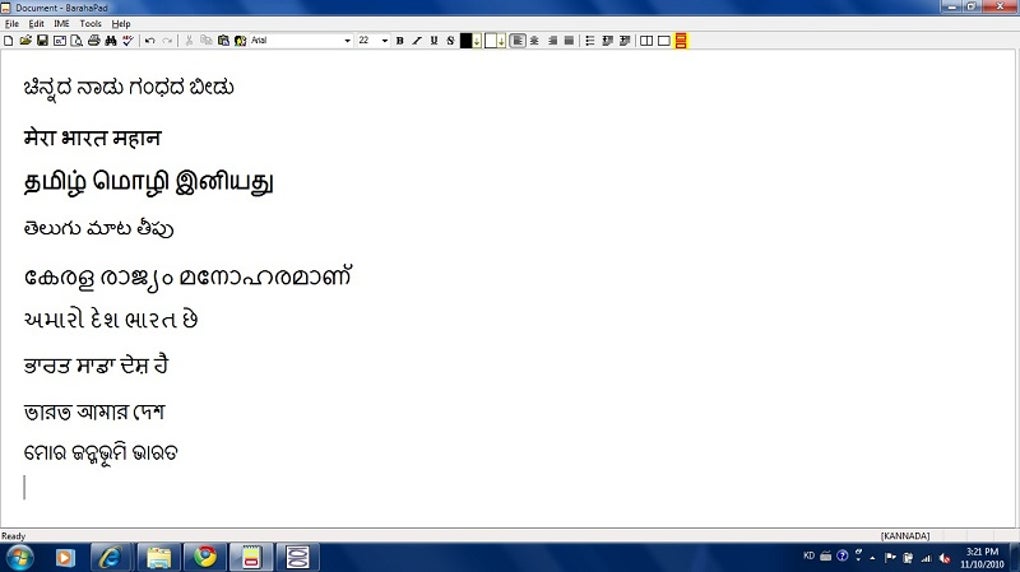
But lack of uniform interests among the various Indian languages used for computing means that sometimes not much can be done on this front. Incidentally, India’s voting member at the Unicode Consortium is the Indian Government’s Ministry of Information Technology (MIT).
KANNADA BARAHA TYPING CODE
Dr Pavanaja underlines the importance of uniformity for the Unicode character table and collation code for this regional language. Also, the Parishad has been working towards a standardised Unicode for Kannada. Sorting and indexing in the regional language has opened up new possibilities. This is used for sorting, as per the Kannada order of the alphabet.
KANNADA BARAHA TYPING SOFTWARE
We have benchmark software too… to ensure that the software will work with any standard computer.” He adds, “standardisation is something that has to be imposed (for the sake of moving ahead together).” At another level, the Kannada language has also pushed for what it calls the Kannada Standard Code for Language Processing.

“In our region, Karnataka has standardised glyph sets already. He says the Indian Government’s stand is that ISCII should have standardised glyph sets. Other solutions have attempted to tie up the user in their own software solutions,” says Dr Pavanaja. “We feel the best solution is to have the storage in ISCII. Text composed on one computer could not be carried over, or understood by another computer that did not share the same software. This meant the data lacked `portability’. But in earlier cases, everyone followed their own glyph sets. Indian groups working on language-solutions such as C-DAC and Mithi have done similar work. For instance, Kannada uses some 142 pieces to obtain all the possible combinations that can be obtained from the 49 Kannada letters of the alphabet.


In addition, the number of characters which make the character (used for storage) and the number of display pieces used for the display of the letter don’t have a one-to-one correspondence. Codes for the storage characters and the display pieces (glyphs) are different. The display of these characters is accomplished by joining pieces of characters known as `glyphs’. These characters have a unique storage code in ISCII, or the Indian Standards Code for Information Interchange. But in the case of an Indian language, say Kannada, the letters are made up of combinations of consonants and vowels, using, for instance, a consonant-plus-consonant-plus-consonant-plus-vowel combination. In the case of English, there is a one-to-one correspondence between the display codes and the storage codes. (The latter refer to the component parts that, when joined together in varying combinations, make up each alphabet.) There’s a big difference between English and Indian languages over the display and storage of information in computers. So far, the standardisation has already been done, both on a uniform keyboard for Kannada, and also for the glyphs and glyph-codes. He’s right now at the helm of the KGP or Kannada Ganaka Parishad (Kannada Computer Association), a voluntary organisation to promote the standardisation and use of Kannada on computers. Over the years, the one-time scientist at Bhabha Atomic Research Centre finds his output increasingly relevant to the common man. “I did it lying in bed with a computer by my side,” he recalls with a smile. This is a game that helps a child or new learner of the Kannada language to shape his alphabet correctly. He then went on to write the first versions of what is now his “Kannada Kali” software programme.

For nine months, as he lay in bed, the scientist learnt Visual Basic. Pavanaja, a 1993 scooter accident turned out to be the proverbial blessing in disguise. To promote the standardisation and use of Kannada on computers?įOR Dr U.B. Kannada Ganaka Parishad (Kannada Computer Association), a voluntary organisation Pavanaja at the helm of the KGP or Kannada Ganaka Parishad (Kannada Computer Association), a voluntary organisation to promote the standardisation and use of Kannada on computers.


 0 kommentar(er)
0 kommentar(er)
